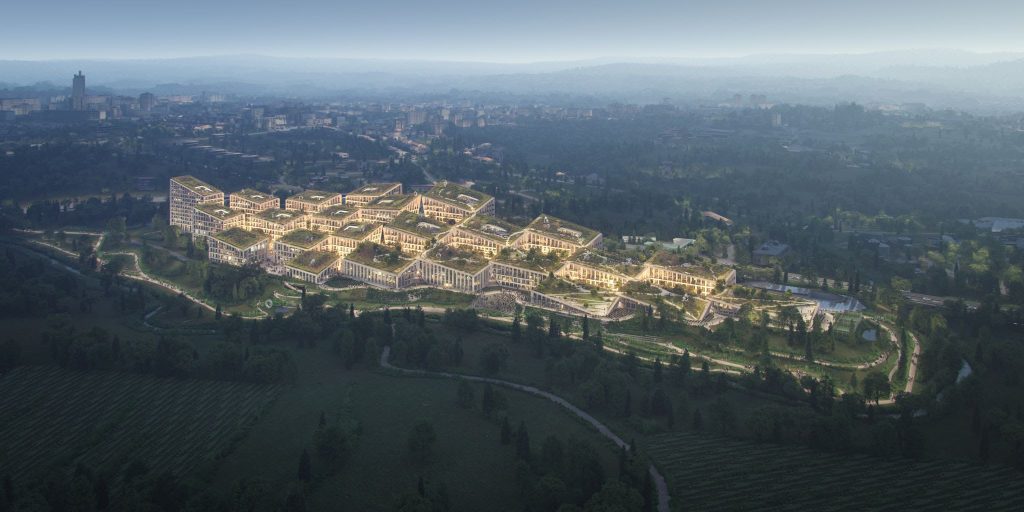
Farfetch, the leading global technology platform for luxury fashion, seeks to further connect creators, curators, and consumers in a purpose-built urban fashion village on the slopes of Leça River in Porto. The 178,000 m2 art-filled site has been named FUSE VALLEY and is developed in collaboration with Portuguese real estate developer, Castro Group.
The future Farfetch HQ features 12 interconnected buildings that each represent the various elements of the company’s organization, with the design of each space tailored accordingly. Scheduled to break ground by early 2023, and open its doors in 2025, the new HQ is situated within the larger FUSE VALLEY site; also designed by BIG, the site of 24 buildings will be home to various tech companies, startups and services. BIG’s design seeks to amplify the exchange of ideas between the different aspects of the organization and create new opportunities for the circa 3,000 Farfetch employees based in Portugal, visitors, and locals.
José Neves, founder, CEO and Chairman of Farfetch, says: “We are very excited about this project and the vision that Bjarke Ingels has presented to us, not only because of what it will mean as a milestone for the company, for our people, but also for the community. This project will be a revolution on the current concepts of workspaces, marked by its futuristic nature, by the orientation towards sustainability and well-being. It will be a space not only for Farfetch, but for the entire community.”

According to Paulo Castro, CEO of CASTRO GROUP, “FUSE VALLEY is the perfect interpretation of our golden rule, applied to all our projects: location, innovation, sustainability, and technology. What we are going to do in Matosinhos is something unique and that puts this space on the international map of what is best done both in terms of sustainability and in terms of innovation. With this project, we intend to develop a smart city, or in this case, a smart valley”.
Conceived as a community village, FUSE VALLEY is organized around plazas, parks, and courtyards which are landscaped and programmed to extend the life inside the buildings to the outside. Like an urban fabric, the individual buildings rest on a series of urban terraces connecting the main road to the east, with the Leça River to the west. Along the central arrival axis, an urban alley opens all the way from the street to the river, featuring all the major public programs and amenities along the riverfront of Farfetch: lobbies, an academy, an auditorium, canteen, and wellness facilities.
“Rather than a corporate office complex, Farfetch’s future home in FUSE VALLEY will be a lively urban ensemble bringing every curator, creator, customer and collaborator together in the most innovative new neighborhood of the city. The urban fabric will allow FUSE VALLEY to grow and expand organically, like a natural village,“ says Bjarke Ingels, Founder & Creative Director, BIG.

As a manmade extension of the hillside, the roofs of the new buildings rise and fall to create peaks and valleys, with slopes and terraces providing employees with generous spaces to enjoy breaks and host gatherings – surrounded by views of the river. Natural paths extend from the landscape to the roofscape, creating flexible wayfinding for people to move around the complex – both inside and out, and above, below, and within the building.

On the ground floor, the facades recede to expand the public realm, creating natural canopies to welcome visitors, collaborators, and customers. The chamfered corners of the buildings merge to create archways and openings between the courtyards that act like canvases for different artistic expressions, bringing color and texture to the streetscape.
Each building is tailored to its specific program, with gently-altered floorplans creating an equally lively and varied interior architectural experience:
“The individual buildings that constitute the various elements of the organization are connected to form large contiguous work environments – physically consolidated, but spatially varied to create a human-scale experience,“ says João Albuquerque, Partner in Charge, BIG.
Atelier-like attics with additional ceiling heights and open mezzanines are created by the sloping roofs of the buildings. Open connections extend from the attic mezzanines all the way to the ground, creating visual and physical connectivity across all floors.
The interior experience prioritizes an immersion in nature, providing a biophilic environment that aims to increase productivity and wellbeing. Similarly, the dense urban fabric and ample vegetation provides a naturally shaded, cooled environment.

The new FUSE VALLEY combines maximum connectivity with a varied visual and physical experience, stimulating human exchange and innovation.
Images: All visualizations by Lucian R, courtesy of BIG – Bjarke Ingels Group
Source : BIG
 Le mie ricette per la real estate community
Le mie ricette per la real estate community